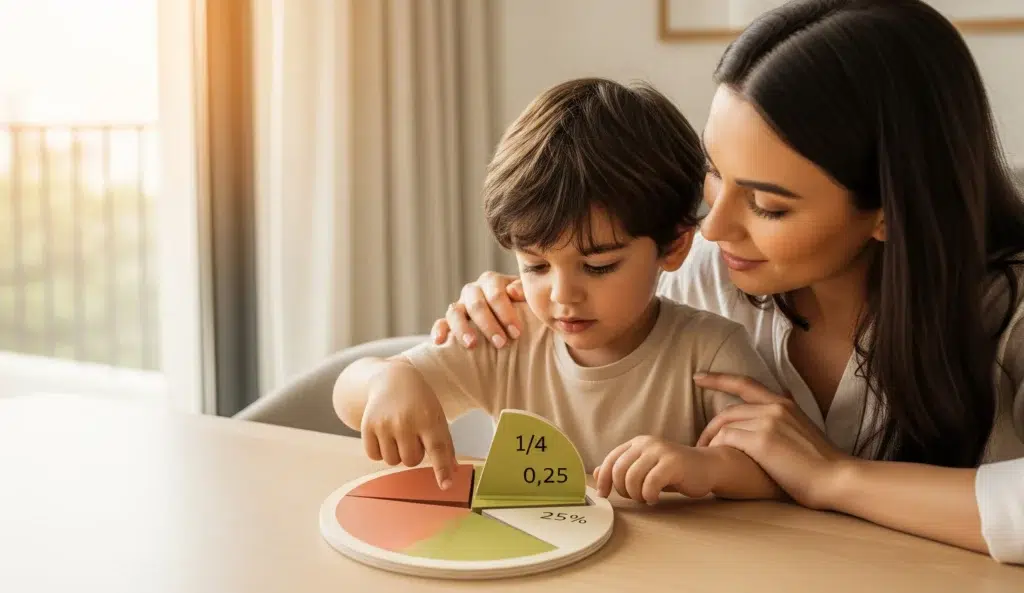Fractions, Decimals, & Percentages Explained: A Visual Guide for Parents
If there is one area of primary maths that causes the most headaches for children and parents alike, it’s the tricky trio: fractions, decimals, and percentages. Your child might be able to handle one of them in isolation, but when a word problem asks them to find 25% of something and then write the answer as a fraction, confusion can quickly set in.
You are not alone in this. The reason this topic is so challenging is that it’s the first time in maths that a single value can be represented in three completely different ways.

The good news is that these concepts are not as complicated as they seem. They are simply different ways of talking about the same thing: a part of a whole. This visual guide is designed for parents in Dubai to demystify this topic, using simple diagrams and real-world examples to help you and your child master it with confidence.
Part 1: Understanding the Three Friends
Let’s quickly re-introduce each concept in the simplest way possible.
What is a Fraction? (The 'Sharing' Number)
A fraction simply represents a part of a whole. The top number (numerator) tells you how many parts you have, and the bottom number (denominator) tells you how many equal parts the whole is divided into.
Think: A pizza cut into 8 equal slices (the denominator). If you eat 1 slice (the numerator), you have eaten 1/8 of the pizza.
What is a Decimal? (The 'Point' Number)
A decimal is another way of showing a part of a whole, but it’s specifically for parts of a whole that has been divided into 10, 100, 1000, and so on. The decimal point separates the whole numbers from the parts.
Think: Money in Dubai! 1 Dirham is a whole. A 50 fils coin is half of a Dirham, which we write as 0.50 AED. The decimal point shows us we are talking about a part of a Dirham.
What is a Percentage? (The 'Out of 100' Number)
“Per cent” literally means “per one hundred.” A percentage is a way of expressing a fraction where the denominator is always 100. It’s a way of standardizing parts for easy comparison.
Think: A mobile phone battery. 100% means it’s full. 50% means you have used exactly half of the battery’s power.
The Magic Link: How They All Relate
Here is the most important secret: fractions, decimals, and percentages are just different outfits for the same number.
The best way to visualize this is with a 10×10 grid, which contains 100 squares.
Let’s look at the shaded area in the grid above:
As a Fraction: 50 out of 100 squares are shaded. That’s 50/100, which simplifies to 1/2.
As a Percentage: 50 out of 100 squares are shaded. “Per hundred” is what percentage means, so it’s 50%.
As a Decimal: 50 hundredths are shaded. We write this as 0.50 or just 0.5.
They all represent the exact same value: HALF.
Bringing it to Life in Dubai: Real-World Examples
Connecting these concepts to everyday life is the key to making them stick.
At the Mall during Dubai Shopping Festival (Percentages): “This shirt was originally 200 AED, but now it’s 25% off. How much do we save?” This is a practical use of percentages.
Sharing a Pizza or Manakish (Fractions): “The za’atar manakish is cut into 4 huge pieces. If you eat one piece, what fraction have you eaten?” This reinforces the concept of parts of a whole.
Measuring Ingredients for a Recipe (Decimals): “The recipe calls for 0.75 litres of milk. Can you see the 750ml mark on the measuring jug?” This connects decimals to real-world measurements.
While these real-world examples are fantastic, some children struggle to transfer that practical understanding back into the classroom. If the abstract nature of these concepts is a consistent hurdle, the personalized attention of a primary maths tutor in Dubai can be incredibly effective at bridging this gap.
Why Rote Conversion Isn't Enough
It’s tempting to just give children a set of rules to memorize (e.g., “to get from a decimal to a percentage, move the decimal point two places to the right”). While these rules are helpful, they don’t build true understanding.
The goal is for a child to develop number sense—an intuitive feeling for the size of these numbers. They should instinctively know that 75% is the same as 3/4 and that it’s bigger than 0.5. This deep understanding is what allows them to solve complex word problems and check if their answers are reasonable.
If you find that your child can follow the rules but can’t explain why they work, or they struggle to apply them in word problems, it may be a sign they need more foundational support. An expert primary school tutor can use visual tools and targeted strategies to build this crucial number sense.
Conclusion: From Three Problems to One Solution
The key to demystifying this topic is to constantly reinforce the idea that fractions, decimals, and percentages are not three separate, scary maths topics. They are three friendly ways of describing the exact same thing.
Use visual aids, point them out in your everyday life, and focus on building understanding before memorizing rules. By making it tangible and relatable, you can empower your child to become confident and flexible in their mathematical thinking.
If you are ready to give your child the personalized support they need to master this and other challenging maths topics, learn more about our dedicated primary tutoring programs.